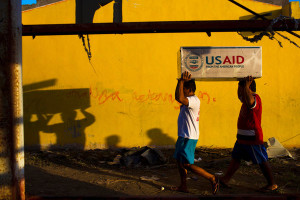
American NGO’s have already jumped in to provide relief and there have been calls from President Obama for more Americans to get involved and help those in need in the Philippines. This includes USGLC members like the American Jewish Joint Distribution Committee, American Refugee Committee, CARE, Catholic Relief Services, ChildFund International, Habitat for Humanity, the International Medical Corps, International Relief and Development, International Rescue Committee, Lutheran World Relief, Mercy Corps, Oxfam America, Plan International, Save the Children, and World Vision. Save the Children and World Vision are already working to assist on the ground by supporting temporary school tents and hygiene kits, while USAID has partnered with organizations like Catholic Relief Services to support relief logistics and distribute supplies, as well as participating in water, sanitation, and hygiene activities in some of the hardest hit provinces.
This includes USGLC members like the American Jewish Joint Distribution Committee, American Refugee Committee, CARE, Catholic Relief Services, ChildFund International, Habitat for Humanity, the International Medical Corps, International Relief and Development, International Rescue Committee, Lutheran World Relief, Mercy Corps, Oxfam America, Plan International, Save the Children, and World Vision. Save the Children and World Vision are already working to assist on the ground by supporting temporary school tents and hygiene kits, while USAID has partnered with organizations like Catholic Relief Services to support relief logistics and distribute supplies, as well as participating in water, sanitation, and hygiene activities in some of the hardest hit provinces.
Equally important is the work of our civilian agencies funded by the International Affairs Budget to get on the ground quickly and assist Filipinos with the recovery from the super typhoon. The American response to the natural disaster has been “swift” and so far the U.S. has given $20 million of humanitarian assistance. The U.S. tends to be one of the first nations on the ground in natural disasters to offer humanitarian relief and this time was no different. According to Secretary of State John Kerry, “A U.S. disaster assistance response team was among the first international groups to reach Leyte province, one of the hardest-hit regions.” The U.S. is continuing to work closely with partners in the Philippines to respond to the disaster.
Like in Haiti, the United States has pulled together partners across the government to provide the most effective assistance. This includes U.S. military forces attached to U.S. Pacific Command providing logistical support to the State Department and USAID to deliver emergency shelter, food, water, and sanitation supplies to Filipinos hit by this tragedy. The coordinated efforts of USAID and PACOM were praised by members of the development community recently. According to Former USAID Administrator Andrew Natsios, “AID and PACOM have worked together for 30 years on these sort of things and they do a very good job when they are left to get their work done and there is no political interference.” As we saw in Haiti, when Americans stand up first and work together to help those tragically affected by natural disasters, it can go a long way in the recovery efforts.
Our hearts go out to the victims of the typhoon and we hope they will soon feel a sense of relief from the hardship they are enduring. But, while we look stunned at the devastation, we also look to the future. Already, careful voices are calling for learning lessons from past disaster relief efforts, paying attention to coordination and sustainability. Through initiatives like the USAID Resilience Strategy and the Partnership for Growth partnership between the U.S. and the Philippines, the U.S. should be in a strong place to coordinate its assistance and help provide the Philippines with the tools it needs to rebuild.